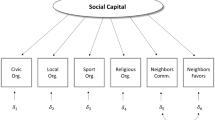Abstract
We empirically assess the effects of individual perception of accessible social capital on individual attitude to thrift in this paper, based on the view that social capital serves as an informal insurance. We look at individual-level data from the World Values Survey. After controlling for demographic characteristics as well as wave and country fixed effects, we find that individual perception of accessible social capital does matter. One who is more generally trusting or has a broader social network tends to value thrift less.

Similar content being viewed by others
Notes
See "Many in U.S. Think Lottery, Not Savings, Is Path to Security", Wall Street Journal—Eastern Edition, 10/29/1999, 234 (85), pA6.
Available at http://www.worldvaluessurvey.org.
A new wave of surveys during 2010–2014 is yet to come.
References
Agarwal, S., Chomsisengphet, S., & Liu, C. (2011). Consumer bankruptcy and default: The role of individual social capital. Journal of Economic Psychology, 32, 632–650.
Alesina, A., & Giuliano, P. (2010). The power of the family. Journal of Economic Growth, 15, 93–125.
Anderson, C. L., & Nevitte, N. (2006). Teach your children well: Values of thrift and saving. Journal of Economic Psychology, 27, 247–261.
Berry, S., Waldron, M., & Williams, R. (2009). Household saving. Bank of England Quarterly Bulletin, 49(3), 191–201.
Bloom, D. E., Canning, D., Graham, B. (2002). Longevity and life cycle savings. NBER Working Paper, No. 8808.
Chou, S. Y., Liu, J. T., & Hammitt, J. K. (2003). National health insurance and precautionary saving: Evidence from Taiwan. Journal of Public Economics, 87, 1873–1894.
Cigno, A., Giannelli, G. C., Rosati, F. C., & Vuri, D. (2006). Is there such a thing as a family constitution? A test based on credit rationing. Review of Economics of the Household, 4(3), 183–204.
Duflo, E., & Saez, E. (2003). The role of information and social interactions in retirement plan decisions: Evidence from a randomized experiment. Quarterly Journal of Economics, 118(3), 815–842.
Erickson, B. H. (1996). Culture, class, and connections. American Journal of Sociology, 102, 217–251.
Fukuyama, F. (1995). Trust: The social virtues and the creation of prosperity. New York: Free Press.
Guiso, L., Sapienza, P., & Zingales, L. (2004). The role of social capital in financial development. The American Economic Review, 94(3), 526–556.
Guiso, L., Sapienza, P., & Zingales, L. (2006). Does culture affect economic outcomes? Journal of Economic Perspectives, 20(2), 23–48.
Inglehart, R., & Baker, W. E. (2000). Modernization, cultural change, and the persistence of traditional values. American Sociological Review, 65, 19–51.
Inglehart, R., Norris, P., & Welzel, C. (2002). Gender equality and democracy. Comparative Sociology, 1, 321–346.
Kantor, S. E., & Fishback, P. V. (1996). Precautionary saving, insurance, and the origins of workers’ compensation. Journal of Political Economy, 104(2), 419–442.
Kashima, E. S., & Kashima, Y. (1998). Culture and language: The case of cultural dimensions and personal pronoun use. Journal of Cross-Cultural Psychology, 29(3), 461–486.
Kashima, E. S., & Kashima, Y. (2005). Erratum to Kashima and Kashima (1998) and reiteration. Journal of Cross-Cultural Psychology, 36(3), 396–400.
Knack, S., & Keefer, P. (1997). Does social capital have an economic payoff? A cross-country investigation. Quarterly Journal of Economics, 112(4), 1251–1288.
Licht, A. N., Goldschmidt, C., & Schwartz, S. H. (2007). Culture rules: The foundations of the rule of law and other norms of governance. Journal of Comparative Economics, 35, 659–688.
Loayza, N., Schmidt-Hebbel, K., & Servén, L. (2000). What drives private saving across the world? Review of Economics and Statistics, 82(2), 165–181.
Nyhus, E. K., & Webley, P. (2001). The role of personality in household saving and borrowing behaviour. European Journal of Personality, 15, S85–S103.
Paxton, P. (2002). Social capital and democracy: an interdependent relationship. American Sociological Review, 67, 254–277.
Platteau, J. (1994). Behind the market stage where real societies exist - Part I and II. Journal of Development Studies, 30(3), 533-577, 753-817.
Portes, A. (2000). The two meanings of social capital. Sociological Forum, 15(1), 1–12.
Putnam, R. (1993). Making democracy work: Civic traditions in modern Italy. Princeton: Princeton University Press.
Putnam, R. (1995a). Bowling alone: America’s declining social capital. Journal of Democracy, 6, 65–78.
Putnam, R. (1995b). Tuning in, tuning out: the strange disappearance of social capital in America. PS: Political Science and Politics, 28, 664–683.
Rothstein, B., & Uslaner, E. (2005). All for all: Equality, corruption, and social trust. World Politics, 58(1), 41–72.
Schafft, K. A., & Brown, D. L. (2000). Social capital and grassroots development: The case of Roma self-governance in Hungary. Social Problems, 47, 201–219.
Son, J., & Lin, N. (2008). Social capital and civic action: A network-based approach. Social Science Research, 37, 330–349.
Stock, J. H., Yogo, M. (2002). Testing for weak instruments in linear IV regression. NBER Technical Working Paper No. 284.
Tabellini, G. (2008). Institutions and culture. Journal of the European Economic Association, 6, 255–294.
Tabellini, G. (2010). Culture and institutions: Economic development in the regions of Europe. Journal of the European Economic Association, 8(4), 677–716.
Van Der Gaag, M., & Snijders, T. (2005). The resource generator: Social capital quantification with concrete items. Social Networks, 27, 1–29.
Wilcox, D. W. (1991). Household spending and saving: Measurement, trends, and analysis. Federal Reserve Bulletin, 77(1), 1–17.
Zak, P. J., & Knack, S. (2001). Trust and growth. The Economic Journal, 111(470), 295–321.
Acknowledgments
The authors wish to thank Alberto Alesina, Mao-Liang Ye, and Sheng-Chun Zhou for helpful comments and suggestions. We gratefully acknowledge financial supports from Hangzhou Normal University (No. 2012QDW106).
Author information
Authors and Affiliations
Corresponding author
Rights and permissions
About this article
Cite this article
Xu, MN., Wang, ML. Individual perception of accessible social capital and attitude to thrift. Rev Econ Household 13, 487–500 (2015). https://doi.org/10.1007/s11150-014-9240-2
Received:
Accepted:
Published:
Issue Date:
DOI: https://doi.org/10.1007/s11150-014-9240-2




